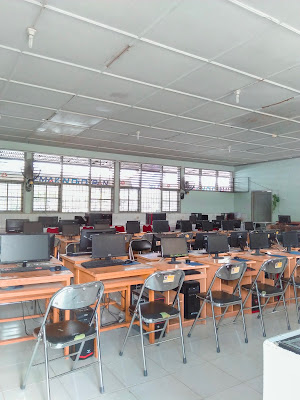Bu Nini teaching in Grade X-MIPA 7
Furthermore, this kind of approach fosters collaborative learning where groupings can be made. I have noticed that when students are grouped they tend to be more participative and engaged with the task. Good thing is that students know how to divide tasks within their circle of group members. Additionally, retention of knowledge is evident in student’s answers during recitation as well as in their assessment.
Discovery Learning Method is also one of the teaching methods use by my cooperating teacher because she lets the students roam around the school to look for a fern plant. After the students found a fern plant, she then asked questions related to the topic which are the characteristics of it. Then, students were tasked to figure out the parts of the fern in front and illustrate it in the board so other students would have clearer view of it. This method makes students active learners instead of passively receiving knowledge. It is like students are learning by doing with the fact that they explore and manipulate real objects, finding answers to worldly common problems, perform investigation and experiments. With this, multiple competencies of the students are strengthen such as their questioning and hypothesizing abilities, collaborative, problem-solving, and scientific skills.
2.2 LEARNING MATERIALS AND INNOVATION
Student's Textual Book in Biology
SMAN 10 is fully equipped with technological tools and facilities which made them advanced when it comes to innovative instruction. Multimedia tools are intensively utilized during class discussion. Before my cooperating teacher started the class, the assigned student prepared the LED Projector, white board, and speakers to be used for the day’s discussion.
Although technological advancement is prominent in SMAN 10, textual books are still readily available for students as their guide throughout the discussion. Teachers have separate books as their reference for instruction and only them are allowed to handle it. During the class discussion, my cooperating teacher also used traditional instructional materials like illustration of the fern reproduction cycle. She also presented a realia of fern plant which significantly helped the students to fully understand the topic.
Students are also allowed to use their cellular phones if they need to search something in the Google. My cooperating teacher believes that letting students access to internet will make them a true 21st century learners. Yet, students are not allowed to use their phones during examinations or quizzes.
In the learning process of the students it is important for them to have an access to sources of information. Regarding this matter, the school administration built various resource centers. Technological facilities are also provided to both faculty teachers and students.
One of the resource centers in the campus is the library where students can freely borrow books and spend their leisure time in there. Normally, students stay inside the library in their free time to study and do their assignments. Teachers often visits the library due to their hectic schedule. Sometimes, they go inside to look for other reference books for their lesson planning. Another is the computer laboratory where students can readily use desktop computers to make their paperworks and other school tasks. They can surf the internet due to accessible internet connection.
To further practice student’s learning in Science subjects, laboratory rooms are open for usage. There are laboratories for Biology, Chemistry and Physics where needed instruments are readily available. It is a good that there are numerous microscopes in both Biology and Chemistry laboratories. In strengthening students manipulative skills in using microscope it is a must that they have adequate time to use it so one microscope is in proportion to two to three students.
2.4 AUTHENTIC ASSESSMENT
Authentic assessment is generally used in Indonesia’s educational system. It aims to assess students’ abilities in ‘real-world’ contexts. My cooperating teacher told me that she gives projects such as research paper, journals, reports and multimedia projects with the students to evaluate their understanding of the subject matter. Basically in this kind of assessment, students are expected to apply their honed skills to authentic tasks or called ‘real-world tasks’. It focuses on how students practice their analytical and critical thinking skills.
Aside from letting the students answer learning worksheets about ferns, the teacher adds some take home project where students have to plant a fern and observe its growth. With this type of assessment, there is an integration of the learned knowledge and skills in making the finished product. Consequently, the attainment of set learning outcomes is realized.






No comments:
Post a Comment